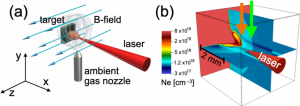Under the influence of magnetic fields associated with astrophysical environments, charged particles can be accelerated to near light-speed in so-called collisionless shocks, i.e. in an interaction over a distance much shorter than the particle’s mean-free path. Apart from the presence of a magnetic field whose role has been generally accepted, though never fully proven, several possible mechanisms have been suggested for this phenomenon which is most notably observed when solar winds enter the earth’s magnetosphere. With the aid of a pulsed magnetic field generator, experiments performed at a high-power laser facility (plasma-generation) have now for the first time reproduced this scenario in a laboratory environment, thereby identifying a dominant mechanism called shock surfing. The experiment is part of a series in laboratory astrophysics involving the Laboratoire pour l’Utilisation des Lasers Intenses (LULI) and the LNCMI.

Figure – (a) Schematic view of the setup used for the experiment. The plasma is generated by laser ablation from a target. b) 3D representation of the piston (plasma cloud) spreading from the target. The orange and green arrow respectively indicate the piston front and the shock front propagating in the ambient medium. Charged particles from the ambient are being accelerated by the electric field associated with the moving shock front.
Publication – Laboratory evidence for proton energization by collisionless shock surfing
W. Yao, A. Fazzini, S. N. Chen, K. Burdonov, P. Antici, J. Béard, S. Bolaños, A. Ciardi, R. Diab, E.D. Filippov, S. Kisyov, V. Lelasseux, M. Miceli, Q. Moreno, V. Nastasa, S. Orlando, S. Pikuz, D. C. Popescu, G. Revet, X. Ribeyre, E. d’Humières, J. Fuchs, Nature Physics 17 1177 (2021)
